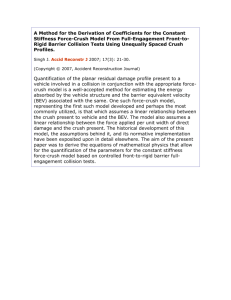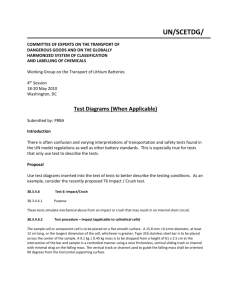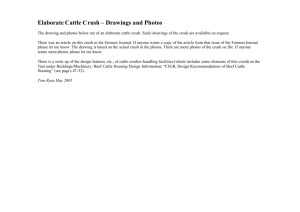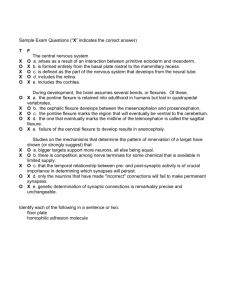Low Carbon Vehicle Technology Project (LCVTP) November 17
advertisement
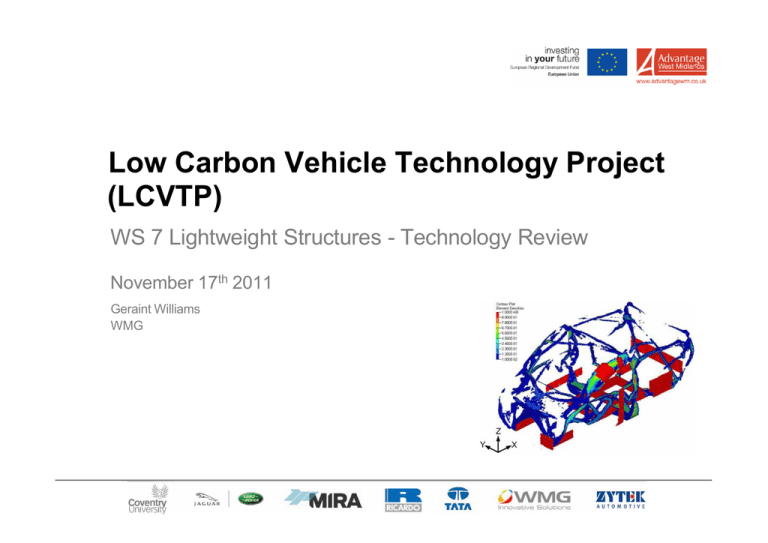
Low Carbon Vehicle Technology Project (LCVTP) WS 7 Lightweight Structures - Technology Review November 17th 2011 Geraint Williams WMG Practical performance evaluation of LCVTP WS7 materials technology concepts Neil Reynolds WMG Contents Introduction Description of the approach to technology performance evaluation Coupon level testing > Materials comparisons > CAE coupon test study > TPC aging Demonstrator component (beam) testing > Dynamic crush > Static flexure > Fatigue flexure Conclusions and next steps Introduction to WS7 mechanical characterisation Purpose: > To establish the structural capability of selected lightweight materials/process technologies against existing benchmarks Approach: > Using a step-wise testing methodology Starting at coupon-level standardised testing Develop CAE tools Culminating in proof-of-concept application related demonstrator component testing WS7 Test approach Selection Demonstration Simulation CR Multiple materials - supplier engagement activities Standardised testing (tensile, flexure, lap shear) Candidate materials versus benchmark materials Testing demonstrator parts (flex, crush, impact) FE model input and benchmarking Develop predictive FE model Technology validation Benchmark performance against predictive models Coupon testing • Static, standardised testing > Basic engineering data for selected materials > Detailed CAE input data for reliable predictive design Coupon testing – aging of PA6-GF • Material aged using 240 hour salt bath immersion (JLR) then tensile tested Coupon testing – CAE case study • 4 tests carried out to develop CAE model input data > Estimating compressive properties Values EA, e11t, xt Test and Fibre Orientation UD Tension 0o EB (=Ec), vBA, e22t, yt UD Tension 90o GAB, τ1, γ1, gms, sc sc , τ1, γ1, gms, Shear (in lamina plane) +/-45o GCA, (=GBC) Shear (interlaminar) 0o Example Simulation Coupon testing – CAE case study Tension testing 0 degrees 90 degrees 0 0.005 0.01 0.015 Axial strain () 0.02 0.025 Coupon testing – CAE case study Shear testing +-45 degree tension 0/90 short beam flex 0 0.05 0.1 0.15 0.2 0.25 Shear strain () 0.3 0.35 0.4 0.45 0.5 CAE case study outcomes Complete, correlated LS-DYNA model for TPC laminate material > Ability to reliably design with alternative materials > Approach for generation of CAE input data set transferable and repeatable for other new materials Performance of candidate material evaluated at a material level > Strength and stiffness > Failure mode and the effect of fibre angle on failure mode investigated Next steps > Develop techniques for reliable evaluation of compressive properties > Variable strain rate and fatigue Demonstrator beam study Experimental build-and-test study using a test component representative of an automotive structural element > Ensuresrelevanceandtransferabilityofresultstoapplication > Enables manufacturing and performance to be evaluated in line with end use expectations Split into 3x main sections: > End-wise dynamic crush > Static 3-point flexure > Fatigue 3-point flexure Beam details • Cross section: 45 x 75mm, length: 450mm (flex)/375mm (crush) End-wise crush Allows the measurement of the energy absorbing efficiency of candidate and benchmark materials in front-end crash test scenario Dynamic spring-assisted falling weight test at two energy levels: > 8kJ, 14.6m/s, 133kg > 4kJ, 7.8m/s, 74kg Test set-up is designed to ensure initiation into progressive failure mode, can evaluate: > Failure mode(s) > Average crush force > Specific energy absorption of each material End-wise crush - comparisons Undamaged length: > Original length – damaged Damaged length region Specific energy absorption (SEA, J/g) > Applied energy / weight of Original length damaged region Undamaged length End-wise crush - comparisons Average crush force: > E=Fxd Total energy Max deflection > F=E/d Incorporates energy contribution from initiation peak and other peaks Average force Crush – PA6-GF60/Alu 5754 comparison video Crush – undamaged length Crush – Average force Crush – Specific energy absorption Crush – effect of joint integrity Non-optimised SPR Threaded fasteners Crush – discussion & conclusions Generally, the TPC material performs well in crush, with superior specific properties to the metallic benchmarks > The SEA of the composite is ≈ 2x that of the metallics The SEA of the composite is ≈ 2x that of the metallics The composite failure mode can be considered ideal as compared to the metallic failure mode: > Material is removed from the crush zone once it can no longer absorb any more energy The joint integrity has a large effect on crush efficiency and failure mode stability: > Components with low/no SPR flare had significantly reduced crush efficiency Flexure testing Simply supported 3-point bend Beam length: 450mm, span 400mm > Quasi-static: 50mm/min, tested up and down > Higher rate: 60mm/s, tested up Understand: > Beam stiffness, strength > Failure mode Static flexure response – closure up Static flexure response – closure down Flexure stiffness Flexure stiffness - specific CAE prediction for optimised TPC beams Linear static FEA Formulate optimised beam lay-up that matches static stiffness properties of: > 5754 aluminium > DP600 > Original PA6-GF60 beam Static flexure – discussion & conclusions The specific flexural properties of beams made using TPC material are comparable to the metallic benchmarks > CAE results demonstrate the weight saving potential of TPC for equivalent stiffness 20% over aluminium, 40% over steel (linear static predictions) The flexural failure mode is dominated by local section crush, but is varied by changing the beam orientation > Closure plate upwards limits local crushing and promotes joint failure in composite parts Flex fatigue - introduction To gain a basic understanding of the fatigue life of the TPC as compared to the metallic Peak flex load materials 80% 80% and 50% of static load R=0.5 6Hz Run-out at 1 x 106 cycles Failure at 40% stiffness reduction Fatigue example – 80%, PA6-GF60 Fatigue – 50%, PA6-GF60 Fatigue example – PA6-GF60 thermography Test start Damage onset Failure Fatigue example – 50%, PA6-GF60 Fatigue outcomes example – 50%, PA6-GF60 Fatigue loading at 80% of the static peak load level: > Both metallic benchmarks continue to 1 x 106 cycles with no stiffness degradation > All composite solutions fail before 50,000 cycles At 50% of the static peak load level: > All composite solutions run-out at 1 x 106 cycles with no stiffness reduction but measurable static displacement offset (creep) > The fatigue life load limit for the composite structures lies between 50 and 80% ultimate flex load Thermography can be used as a tool to measure damage accumulation within the TPC structures > Reduction in stiffness (damage) correlates closely with temperature increases Overall conclusions Engineering polymer TPC glass fibre laminates can offer a structural alternative to aluminium and steel with significant weight saving: > Crash: ~50% compared to Aluminium, >50% compared to steel > Stiffness: 20% reduction on Aluminium, 40%against steel Further work: > Crush: investigate and improve mechanical joining method to further optimise crush efficiency for TPCs > Flexure: manufacture and test modified lay-up as recommended by FEA to confirm performance predictions > Fatigue: perform in-depth coupon study to determine effect of fibre lay-up and damage evolution using calibrated thermography
